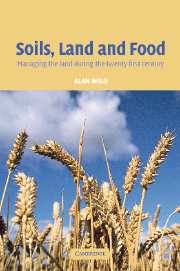Book contents
- Frontmatter
- Contents
- Preface
- Acknowledgements
- 1 Managing land for food production in the twenty-first century: an outline
- 2 Natural resources for sustainable land management
- 3 The development of agriculture and systems of land management
- 4 Maintaining and improving soil fertility
- 5 Land degradation and its control
- 6 Raising yields: use of fertilizers
- 7 Raising yields: water for rainfed crops and irrigation
- 8 Managing change of land use: seven examples
- 9 Increasing and sustaining agricultural production
- 10 Increasing agricultural production: the examples of Africa, India and China
- 11 Prospects and uncertainties
- References
- Index
7 - Raising yields: water for rainfed crops and irrigation
Published online by Cambridge University Press: 05 June 2012
- Frontmatter
- Contents
- Preface
- Acknowledgements
- 1 Managing land for food production in the twenty-first century: an outline
- 2 Natural resources for sustainable land management
- 3 The development of agriculture and systems of land management
- 4 Maintaining and improving soil fertility
- 5 Land degradation and its control
- 6 Raising yields: use of fertilizers
- 7 Raising yields: water for rainfed crops and irrigation
- 8 Managing change of land use: seven examples
- 9 Increasing and sustaining agricultural production
- 10 Increasing agricultural production: the examples of Africa, India and China
- 11 Prospects and uncertainties
- References
- Index
Summary
INTRODUCTION
The context in which soil water and irrigation have to be considered is (ⅰ) irrigated agriculture accounts globally for one-half to three-quarters of total water consumption, including domestic and industrial use (Postel et al., 1996); (ⅱ) about one-third of the global harvest is from one-sixth of the agricultural land area that is irrigated; and (ⅲ) much of the five-sixths of the land area that grows rainfed crops has marginally sufficient rainfall. Because of the limited supplies of fresh water for irrigation (see Chapter 2) and, in marginally dry areas, of the need to conserve rainfall, efficient management of water for agricultural use is essential. In order to understand how this might be achieved, an outline of the main concepts used to describe soil water and its use by crops is first given.
By the end of the nineteenth century significant progress had been made in understanding the physics of soil water (Warington, 1900). It had been shown by then that the amount of water held in a soil against gravity was related to its particle size distribution, and that water moved in soil under the influence of gravity, by capillary action and in the vapour phase. Warington also referred to practical applications of this information to rainfed and irrigated agriculture.
Probably the two most significant advances in the twentieth century were firstly the unifying concept of the free energy of soil water, usually described in terms of potential or suction, and secondly the use of meteorological conditions to calculate the rate of evaporation of water from crops based on the physics of the process.
- Type
- Chapter
- Information
- Soils, Land and FoodManaging the Land during the Twenty-First Century, pp. 109 - 126Publisher: Cambridge University PressPrint publication year: 2003



